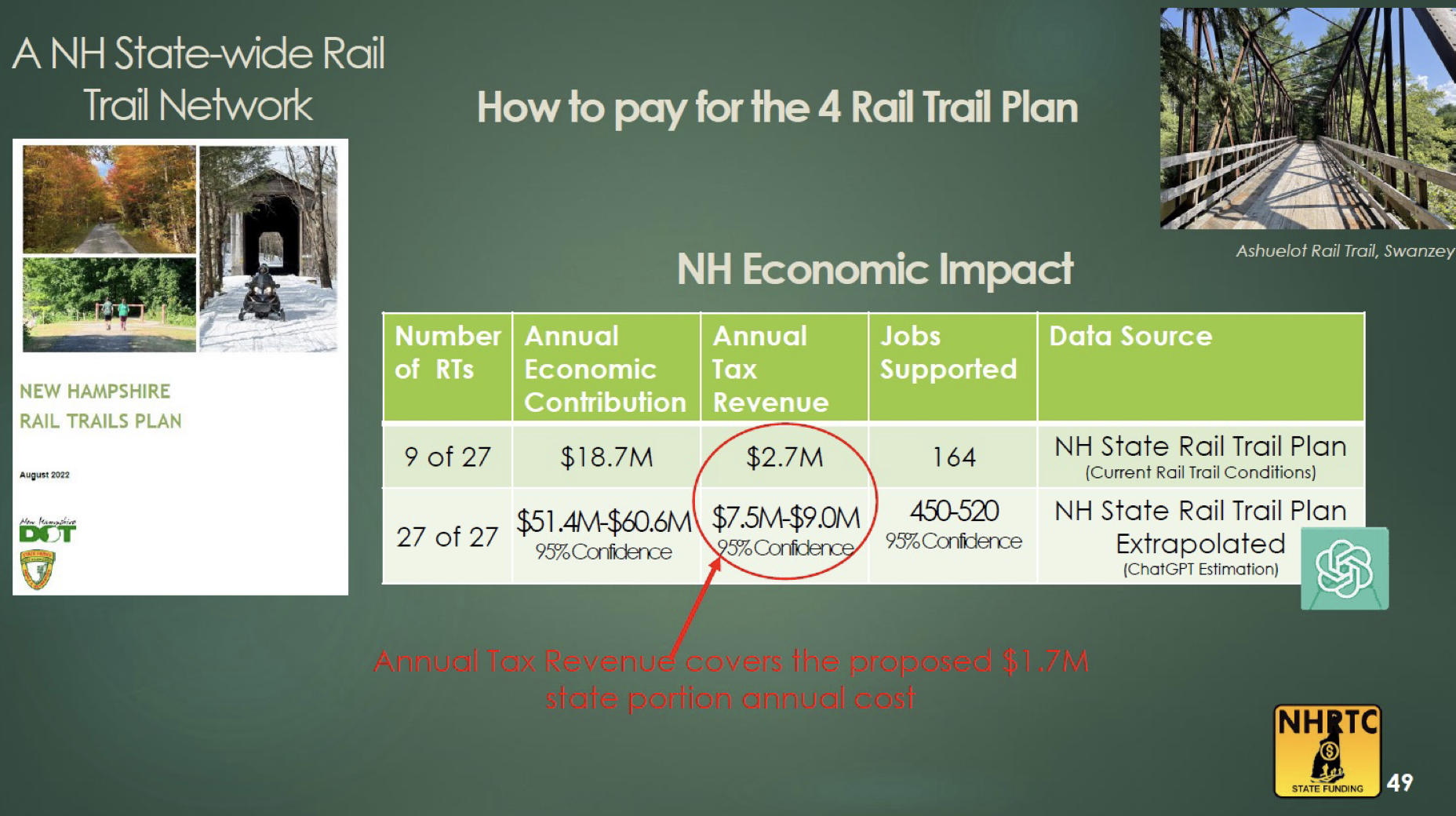Time to Support Rail Trail Funding: Bill SB 274-FN
Update 4/7/2025: NHRTC has submitted a letter to Gov. Ayotte, who has made outdoor recreation a centerpiece of her administration, to gain support in advance of final budget discussions. You can increase our chances of passage by telling your Senators, Representatives, and Governor Ayotte that you want them to pass SB274, preferably at its original funding levels. Thank you!
How we got here: With Senator Donovan Fenton as prime sponsor we are working hard to pass Rail Trail Funding bill SB 274-FN .
The bill title says it well: “establishing a 4-year pilot program with potential for statewide expansion to improve rail trails in New Hampshire through federal, state, and private funding and making a bonded appropriation therefor.”
The NHRTC team testified to the Senate Transportation Committee in support of SB274 on February 11, 2025. Public support was more than 10 to 1 in favor. The Committee voted unanimously to pass the bill, albeit with a greatly reduced budget request. Click on following links to see written testimony from Mike Kowalczyk (NHRTC), Marianne Borowski (Cross-NH Adventure Trail), and Boyd Smith (NHRTC volunteer).
Email Mike Kowalczyk , Marianne Borowski, or Boyd Smith if you have any questions. We look forward to your creative commitment to help build New Hampshire’s new and improved, world-class rail trail system!
We will continue to update this page and broadcast our call to action as far and wide as possible. You can increase our chances of success by sharing this information with all your contacts, and by telling your local representatives about your support.
Background:
The NH Rail Trails Coalition is pursuing State funding for rail trails! With a clear mandate from October 2023 NHRTC biennial conference attendees, our Board authorized Directors Marianne Borowski and Mike Kowalczyk, with volunteer Boyd Smith, to pursue state funding to improve the 338 miles of NHDOT-owned abandoned rail corridor. Our team’s approach is to help implement the 2022 NHDOT “State Rail Trails Plan”, which identified the following highlights:
- Economic analysis indicated 9 of 27 existing public rail trails generate $18.7 million economic activity annually, with $2.7 million in taxes and 164 jobs. Our statistical analyses indicate that 27 of 27 trails likely generate $7.5Mm to $9.0 Mm/year in tax revenue. National data indicate 5-fold economic growth is possible.
- Longer trail systems attract more out-of-state visitors, which results in higher economic benefit. Connecting existing trails is the most effective and efficient way to build longer trail systems.
- State funding is required to build and maintain a world-class rail trail system.
Roughly one-third of New Hampshire’s population lives within one mile of a rail trail, with over 90 percent living within ten miles of a corridor. In addition to boosting local economies, rail trails promote stronger communities, better health, and safer modes of transportation.
The Whole Enchilada
As of September 2024, the NHRTC team compiled cost estimates to build and maintain abandoned state-owned rail corridors to a similarly high level of quality; prepared a digital presentation that outlines project benefits, scope, costs, and funding mechanisms; met with Commissioners and senior staff of the principal State rail-trail management agencies (NH DOT, DNCR, Fish & Game, and BEA); and solicited business and political leaders for their insight. On all fronts, our ideas were enthusiastically and positively received!
Our initial approach was to bring all 338 miles of state-owned rail trail to a similar level of quality. Using actual costs from existing projects, we estimated $100Mm – $130 Mm to build and maintain this complete system. While our analysis and data provide a solid foundation for future work, we quickly learned that a more modest approach was required.
A Phased Approach
In an April 2024 meeting, DOT and DNCR informed us of their desire to transfer ownership of four trails (83 miles, or roughly 25% of the State total) to DNCR. We quickly revised our proposal to use this opportunity for a scalable, four-year phased project. Our core strategy is to build Bureau of Trails (trail management and maintenance) and Fish and Game (trail safety and enforcement) capacity to leverage federal funds and private contributions, and to demonstrate the value of improving existing rail trails. We targeted a portion of tax revenues generated by current trail activities as the principal source of state funds.
The following two slides from our full presentation summarize this approach:
State Agency Capacity Building – Where the Money Goes

State Funding – Where’s the Money From: Use a portion of Existing Trail Revenue

With Senator Fenton’s guidance and assistance, we are seeking bi-partisan and bi-cameral legislative approval and Governor’s signature by July 2025.
Make a Donation to NHRTC Online using the blue button below:
